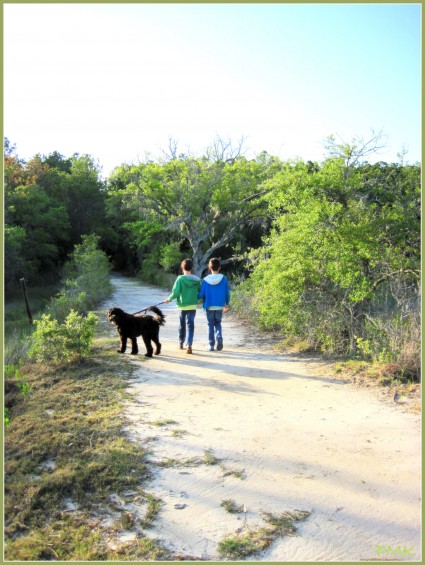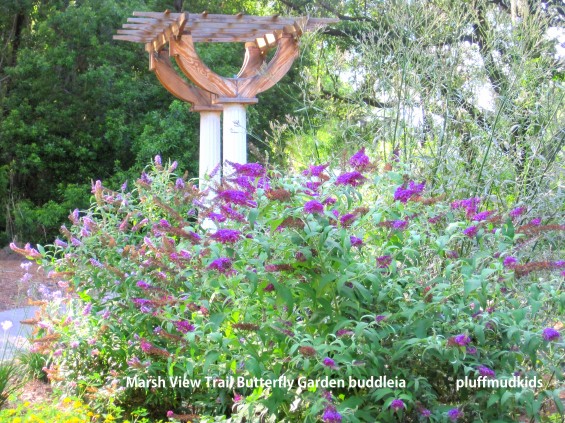Less than 50 years ago, Rifle Range Road was a quiet rural route surrounded by small farms. Today the farms are gone and cars speed by, bringing folks to one of the many residential neighborhoods that line the roadway. Many are unaware of a hidden retreat that lies behind the Mount Pleasant Waterworks complex.
When I was asked to write about Marsh View Trail, my first response was “What’s that?” I met Catherine Main, Executive Director of the East Cooper Land Trust, at the entrance to the trail located behind the Mount Pleasant Waterworks complex on Rifle Range Road, and we strolled the quarter-mile paved walkway which meanders through fifty areas of woods and marsh lands. I left Mann armed with a folder of information but there was still much to learn about this “secret garden.” I elicited the help of my friend Julie Cliffe, a former Wando High School biology teacher. Julie was excited because she too had no former knowledge of the trail. A few days later as I waited for Julie on an overcast Sunday an older couple emerged from the entrance and as we chatted they acknowledged that they were frequent trail walkers and asked me if I knew of other local sites with natural trails. I had to admit other than the marshwalk that circles the I’On community, I knew of no others. As Julie and I prepared to begin our walk the couple warned us that the path was flooded from the rain the day before.
Not far from the entrance is the dog park, consisting of two fence enclosures, one for large and one for small dogs. We passed a young man with a chocolate lab who also warned us that it was wet. Undaunted we headed to the Butterfly Garden, where plants and flowering shrubs, specially selected to attract butterflies, were slowly emerging from the harsh winter weather. The Butterfly Garden was added in the spring of 2012, a project made possible by community volunteers. Just to the left of the garden is a beehive, a recent Girl Scout project, and the bees were active on this day.
Armed with a handout we picked up at the information board, Julie and I headed along the trail carefully dodging puddles. As we entered a densely wooded area, Julie explained that this is one of the few maritime forests remaining that are assessable to the public. A canopy of loblolly pine, live oak, laurel oak and magnolia almost blocked out the sky and Julie remarked, “I bet this is cool in the summer.” We hadn’t gone too deeply into the forest when we discovered the trail was buried under water; after all, marsh lands have a propensity for returning to their natural state following heavy rains. As we returned to the Butterfly Garden a young female jogged past us and we shouted a warning that was ignored. While we sat on one of the benches in the garden, the jogger returned and said, “I should have listened to you.”
Julie and I returned a few days later to complete our tour. She was pleased to see that the forest land was left in its natural state with an abundance of native shrubs. It reminded me of the woods behind my childhood home where my brothers and I spent most of our youth exploring.
As the trail transitions into the salt marsh, there are smaller and fewer trees due to the salt spray. Julie pointed out the bright red shiny berries of the yaupon holly that are a particular favorite of local birds, among them the colorful male buntings, visible from April until September. She showed me the edible pickle weed; and we tried to identify tracks that led across the trail into sandy marsh paths.
The smell of pluff mud greeted us just as the scene changed again and opened to a breathtaking panoramic view of the marsh. A protected bench invites visitors to relax and observe the ever-changing marsh, as the seasons and tides offer an exceptional habitat for numerous birds, fish, mollusks and other water species. It was low tide, and Julie explained the mating ritual of the male fiddler crab waving their dominant claw in hopes of attracting an admiring female. She showed me trails etched in the mud made by the tiny periwinkle snails as they glean algae from the sand and plant life. As we sat and chatted on the bench we gazed across the marsh at the raised land masses with trees and other green foliage, remnants of old sand dunes, known as hammock islands. To the left and barely discernible is the Isle of Palms Connector, and, far to the right and mostly hidden, is the causeway leading to Sullivan’s Island. We were soon joined by a older woman and her two beautiful black labs who bounded up to greet us, but soon lost interest and dove into a nearby creek.
At the beginning of the millennium, the Town of Mount Pleasant became aware that due to the town’s rapid growth natural lands were being lost to development. In 2002 the Town created the East Cooper Open Space Foundation with a mission to “identify and conserve natural spaces of environmental, cultural or historical value.” They also sought to “provide natural lands such as parks, gardens and trails for people to enjoy.”
In 2009 the foundation obtained autonomy from the town and became the Mount Pleasant Land Conservancy. A year later the MPLC acquired a conservative easement of 57 acres behind the Mount Pleasant Operation Center at 1619 Rifle Range Road for the Marsh View Trail. In 2013, the MPLC realized that its scope and vision extended beyond Mount Pleasant’s boundaries and became the East Cooper Land Trust, which encompasses the area between the Cooper and Santee Rivers. Catherine Main partners with community volunteers to expand the organization’s mission and sphere by identifying vanishing natural lands and establishing protective easements, so that these lands will be enjoyed by future generations. The ECLT seeks help from the community, especially local businesses through the “Green for Green” program.
Hopefully the Marsh View Trail will be the first of many “green” trails in the East Cooper area so that children can continue to discover the wonders of nature and adults can enjoy a carefree run with a canine pal along natural pathways. To learn how you can help ECLT visit [email protected] or call 843.224.1849.
Story by Pamela Gabriel
Photos by Leigh Sabine



Leave a Reply